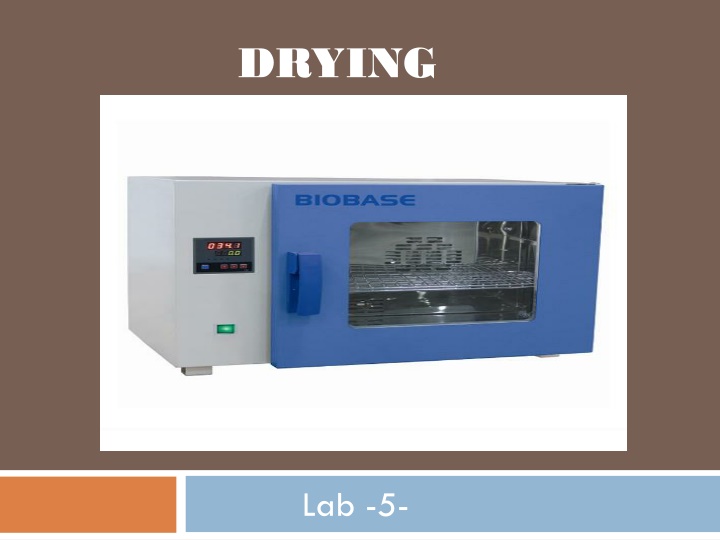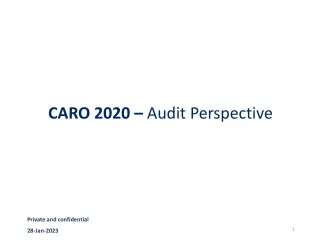
The Importance of Drying in Material Processing
Explore the concept of drying, its purposes, factors affecting the process, classification of solids based on drying behavior, and types of dryers used in various industries. Learn how drying aids in material preservation and facilitates manufacturing processes.
Download Presentation

Please find below an Image/Link to download the presentation.
The content on the website is provided AS IS for your information and personal use only. It may not be sold, licensed, or shared on other websites without obtaining consent from the author. If you encounter any issues during the download, it is possible that the publisher has removed the file from their server.
You are allowed to download the files provided on this website for personal or commercial use, subject to the condition that they are used lawfully. All files are the property of their respective owners.
The content on the website is provided AS IS for your information and personal use only. It may not be sold, licensed, or shared on other websites without obtaining consent from the author.
E N D
Presentation Transcript
DRYING Lab -5-
Drying Drying :- is the removal of liquid from material by application of heat. Drying transfer of a liquid from a surface into an unsaturated vapor phase. It is accomplished by
Purposes of drying: 1- Unit of process in pharmaceutical manufacturing (e.g. preparation of granules then dispense as capsules or tablets). 2- Reduce bulk and weight lower the cost of transportation and storage. 3- Aid in preservation of animal and vegetable drugs by minimizing mold and bacterial growth in moisture laden material 4- facilitate comminution by increasing friability.
Factors affecting drying 1-Drying temperature 2- Moisture content of the sample 3- Air flow rate 4- Agitation of the sample bed 5- Layer thickness of the sample 6- Type of the material
Classification of solids on drying behavior 1- Granular or crystalline solids (water is held in shallow and open surface pores as well as in interstitial spaces between particles that are easily accessible to the surface). Ex: calcium sulfate, zinc oxide, magnesium oxide 2- Amorphous, fibrous or gelatinous solids (moisture is an integral part of the molecular structure as well as being physically entrapped in fine capillaries and small interior pores). Ex: starch, insulin and aluminum hydroxide. Note: Amorphous solids are difficult to dry than granular or crystalline solids.
Classification of Classification of dryers based on solid on solid handeling handeling dryers based 1- Static-bed dryers- systems A- tray and truck dryers B- tunnel and conveyor dryer 2- moving-bed dryers-systems A. turbo-tray dryer B. pan dryer 3- fluidized - bed dryers systems 5- specialized drying methods A- Freeze dryer B- microwave drying 4- pneumatic dryers system
1 1- - Static Static- -bed dryers bed dryers- - systems systems A- tray and truck dryers: it consist from cabinet in which the material dried is spread on tiers of trays .
1 1- - Static Static- -bed dryers bed dryers- - systems systems B- tunnel and conveyor dryer: an adaptation of truck dryer for continuous drying.
2 2- - moving moving- -bed dryers bed dryers- -systems systems The drying particles are partially separated so that they flow over each other. A. turbo-tray dryer B. pan dryer (generally Used for small patches of pastes and slurries)
3 3- - fluidized fluidized - - bed dryers systems bed dryers systems Solid particles are partially suspended in upward moving gas steam.
4 4- - pneumatic dryers system pneumatic dryers system Like spray drier, where the drying particles are entrained and conveyed in a high velocity gas stream. It is only used for drying of fluid materials like paste and slurries.
5 5- - specialized drying methods specialized drying methods A- Freeze dryer
5 5- - specialized drying methods specialized drying methods B- Microwave drying:- here instead of applying heat externally to material, energy in form of microwaves is converted into internal heat by interaction with material itself
Solids drying Solids drying The moisture in a solid can be expressed on a wet-weight or dry-weight basis. Wet-weight basis: loss on drying %LOD = wt. of water in sample 100 total wt. of wet sample Dry-weight basis: moisture content %MC = wt. of water in sample 100 wt. of dry sample Note: MC can be measured by using moisture analyzer or by using oven
Procedure 1- Weight a specific amount of the moist material (wet weight Ww), which depends on particle size (less weight for smaller particles) and on the moisture level (less weight for high moisture level). 2- Place the wet sample in oven for a certain period (until no further change in the weight is observed). 3- Place the dried sample in a desiccator (to reach the room temperature and avoid the absorption of atmospheric moisture). 4- weight the dry sample (dry weight Dw) 5- Calculate the %MC and % LOD using the following equations MC = ?? ?? % %MC ?? % %LOD LOD = ?? ?? ??
Example If exactly 7 g of moist solid is brought to a constant dry weight of 5 g: MC = ?? ?? ?? MC = 7 5 5 Whereas LOD = ?? ?? ?? LOD = 7 5 7 % %MC x 100 = 40% % %LOD x 100 = 28.57%
For more information you can follow these links https://www.youtube.com/watch?v=VkVu5qDgs_Q https://www.youtube.com/watch?v=MEKHkpgVZog














